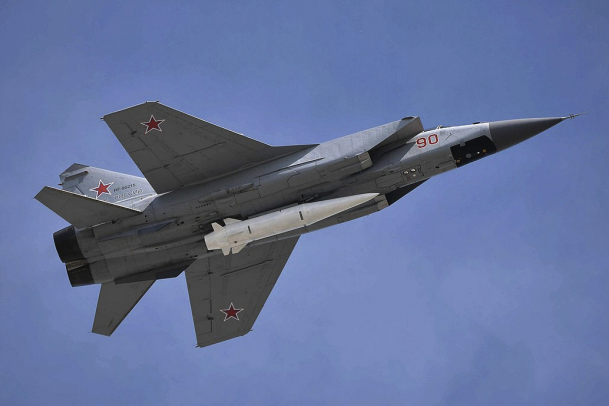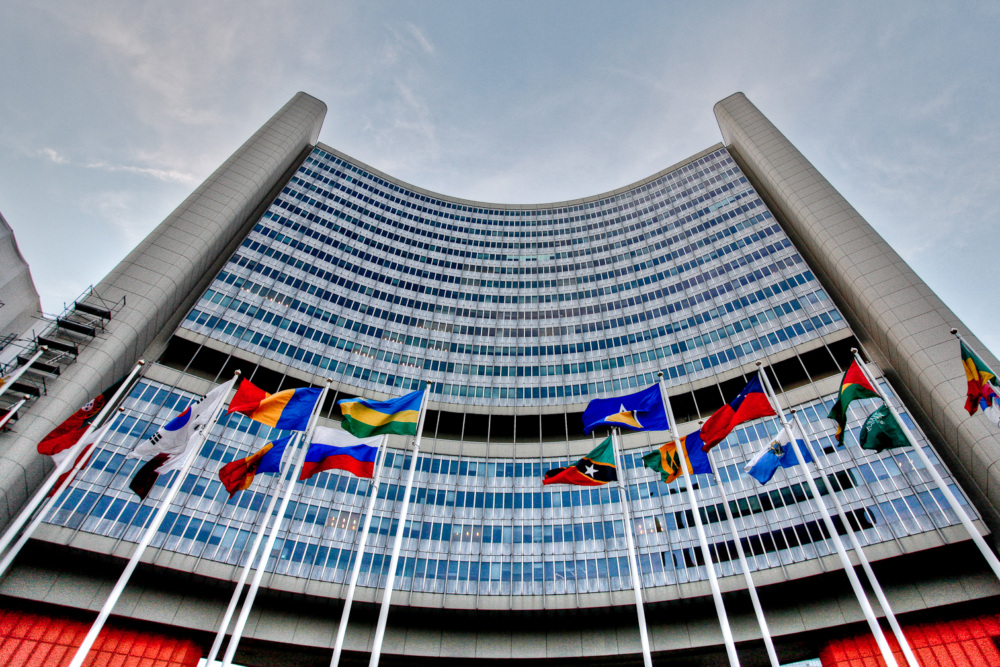
Lia Sokol
Intern, Global Nuclear Policy Program
Atomic Pulse
About the image
In mid-March, as the first month of Russia’s war on Ukraine neared a close, Russia launched hypersonic “Kinzhal” missiles at multiple military sites around the war-ravaged country. Although the Kremlin has called these weapons “unstoppable” and said they have no match in the West, Western media has drawn mixed conclusions about whether the Kinzhal is a cause for concern.
“Putin Unleashes ‘Invincible’ Missile,” wrote London’s Sunday Express tabloid in the aftermath of the Kinzhal’s use. Others, including MSNBC, reached the quick conclusion that President Putin was “showing off” his country’s advanced weaponry after a surprisingly poor performance in the ground war. Experts call the Kinzhal “unremarkable,” though others highlight unintended irony in President Biden’s statement that it is much like “any other launched missile… except that it is almost impossible to stop it.”
What is the Kinzhal, and why did Russia employ it in Ukraine? What are the implications of its use?
What is the Kinzhal missile?
The Kh-47M2 “Kinzhal” (“Dagger” in Russian) is a nuclear-capable, air-launched, hypersonic ballistic missile, one of six new “next generation” weapons unveiled by Vladimir Putin in March 2018. Although Russia has kept its development process secretive and not released many details about the missile, open-source reporting, including a 2019 analysis for NTI by then-Sam Nunn Distinguished Fellow Jill Hruby, suggests the weapon can carry both conventional and nuclear warheads, with a payload of up to 480 kg (1,060 lb) and a thermonuclear option with a 10-50 kt warhead. It is designed to be launched from MiG-31 fighter jets at altitudes of about 18 km (59,000 ft) and can travel at least five times the speed of sound (the definition of hypersonic), or Mach 5. The Kinzhal may reach speeds of up to Mach 10 (12,350 km/hr).
The Russian Ministry of Defense announced on March 18 that it had deployed the Kinzhal to destroy an underground warehouse for missiles and aviation ammunition in the western part of Ukraine. The following day, the Defense Ministry released a video of the attack and claimed that it had also used the Kinzhal to destroy a Ukrainian storage base in the Mykolaiv region. These incidents were reported by Russian news agencies to be the first uses of Kinzhal missiles in its invasion of Ukraine, though the system may have been previously tested in Syria under war conditions.
How advanced is it?
Following Russia’s announcement, a variety of reports emerged from Western sources regarding both the legitimacy of Russia’s report and the significance of the Kinzhal. President Biden confirmed on March 22 that the weapons used were hypersonic, although certain details of the attacks—such as location and timing—are still unclear.
Despite Russia’s claims about the Kinzhal and its development of other “next generation” systems, many experts in the West say the significance Russia ascribes to these weapons is exaggerated. The Center for Strategic and International Studies notes, for instance, that “Russia’s designation of the Kinzhal as a ‘hypersonic’ missile is somewhat misleading, as nearly all ballistic missiles reach hypersonic speeds… at some point during their flight.” Furthermore, the United Kingdom’s Ministry of Defense stated that the use of the Kinzhal was “likely intended to detract from a lack of progress in Russia’s ground campaign” and “unlikely to materially affect the outcome of Russia’s campaign” in Ukraine.
Analysts believe that the Kinzhal is derived from the ground-launched 9K720 Iskander-M short-range ballistic missile. Both weapons achieve hypersonic speeds through a “quasi-ballistic,” unpredictable flight trajectory without departing the atmosphere. The primary difference between the Kinzhal and its purported predecessor is that the Kinzhal is launched by an airborne vehicle rather than from the ground, making it less predictable, harder to intercept, and potentially more survivable than the Iskander ground system.
While the Kinzhal travels at hypersonic speeds, it likely is not as advanced as Russia suggests. Modern hypersonic weapons, which are being developed by China, Russia, and the United States, fit under the category of either hypersonic glide vehicles or hypersonic cruise missiles, while the Kinzhal—an air-launched ballistic missile—falls into neither of these categories.
Why did Russia use the Kinzhal?
Various theories have emerged as to why Russia chose to employ the Kinzhal, given that its strategic capabilities do not appear to significantly change the situation on the ground in Ukraine.
Some analysts have suggested that the destructive power of the Kinzhal system would make it more efficient at destroying underground storage sites. Alternatively, other Western analysts have theorized that Russia may be running out of Iskander short-range ballistic missiles and is using the Kinzhal instead. From a strategic point of view, Russia could have employed the weapon as a sign to both Ukraine and NATO that it is able and willing to escalate the conflict.
Others posit that the Kinzhal use may have little to no strategic motivation behind it at all. Instead, it may be as much a marketing strategy aimed at boosting Russia’s foreign military sales by exaggerating the missile’s capabilities and showcasing Russia’s military prowess.
Finally, some experts conclude that the two Kinzhal strikes on Ukraine had different objectives: while the first appeared to have a genuine military mission of striking underground weapons storage facilities, the second may have simply been to test the new system in an operational environment. Russia used the conflict in Syria to test various new weapons systems, and it is likely that the current conflict in Ukraine is being used for the same purpose.
An “invincible” weapon of war?
While the Kinzhal is a dangerous weapon, most analysts conclude that it is not substantially different from weapons that have been in use for decades. Its “hypersonic” designation, in this case, appears to be only nominally meaningful. Still, its use highlights the so-called hypersonic arms race, as Russia, the United States, and China continue funding research and development of this class of weapons and seeking to claim and/or demonstrate the success of those efforts. Although the Kinzhal may not pose a novel threat, Russia’s decision to use it—and to publicize its use—in Ukraine is likely intended as a message to the United States and NATO about Russia’s capabilities, its commitment to the war effort in Ukraine, and its broader strategic posture.
Sign up for our newsletter to get the latest on nuclear and biological threats.
Trump and Biden Spar over North Korea Threat in Final 2020 Debate
Governments should use the 2024 International Conference on Nuclear Security (ICONS) to reaffirm their commitment to preventing nuclear catastrophe.
For Black History Month, Jupiter Huang, NTI’s communications intern, had the opportunity to ask Tiffany Blanchard-Case, director of the Office of Nuclear Material Removal and Elimination at the National Nuclear Security Administration (NNSA), about the importance of mentorship and her advice for young people interested in working on nuclear issues.



